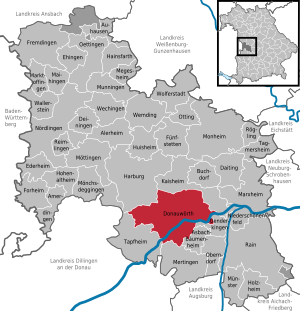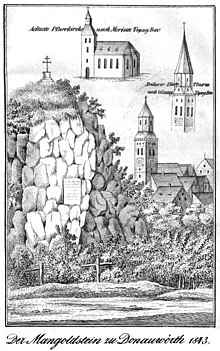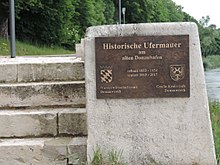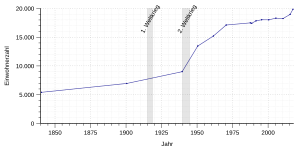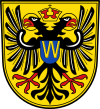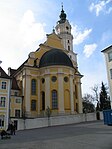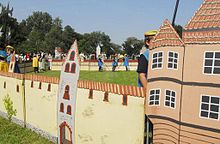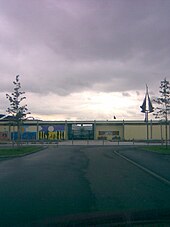Donauwörth
| coat of arms | Germany map | |
|---|---|---|

|
Coordinates: 48 ° 43 ' N , 10 ° 47' E |
|
| Basic data | ||
| State : | Bavaria | |
| Administrative region : | Swabia | |
| County : | Danube Ries | |
| Height : | 410 m above sea level NHN | |
| Area : | 77.04 km 2 | |
| Residents: | 19,590 (Dec. 31, 2019) | |
| Population density : | 254 inhabitants per km 2 | |
| Postal code : | 86609 | |
| Area code : | 0906 | |
| License plate : | DON, Lower Austria | |
| Community key : | 09 7 79 131 | |
| City structure: | 34 parts of the community | |
City administration address : |
Rathausgasse 1 86609 Donauwörth |
|
| Website : | ||
| Lord Mayor : | Jürgen Sorré (independent) | |
| Location of the city of Donauwörth in the Donau-Ries district | ||
Donauwörth (originally Werd, until 1607 Schwäbischwerd ) is a large district town in the Swabian district of Donau-Ries and the seat of the district office .
In the late Middle Ages and early modern times , Schwäbischwerd was an independent imperial city in the Holy Roman Empire , which is reflected in the coat of arms of today's city of Donauwörth.
geography
Geographical location
The city is located in northern Swabia , at the mouths of Kessel and Wörnitz (both from the north) and Zusam and Schmutter (both from the south) in the local Danube , which runs from southwest to east ; The Lech, which comes from the south, flows into this river about 12 km east of the city . Donauwörth is located on the southwestern foothills of the Franconian Alb with the Altmühltal nature park and on the eastern foothills ( Riesalb ) of the Swabian Alb . On the other side of the Danube, a few kilometers south of the city, is the Augsburg-Westliche Wälder Nature Park .
Expansion of the urban area
The municipality has 34 officially named municipal parts (the type of settlement is indicated in brackets ):
|
|
|
|
The community consists of 9 districts :
- Donauwörth (residents: 7,304)
- Auchsesheim with Schwadermühle (residents: 737)
- Berg with Binsberg, Schöttle, Walbach, Kreuzhof and Ramhof (residents: 889)
- Nordheim (residents: 780)
- Riedlingen with Neudegg, Posthof, Quellhaus, Seibertsweiler and Spindelhof (residents: 4,127)
- Sheepfold with Eckhof, Karweiserhof, Lehenhof and Schweizerhof (residents: 248)
- Wörnitzstein with Dittelspoint, Felsheim, Huttenbach, Maggenhof, Osterweiler, Reichertsweiler and Schwarzenberg (residents: 815)
- Zirgesheim with Lederstatt, Stillberghof and Schiesserhof (residents: 858)
- Zusum (residents: 60)
Geographical settlement situation of Donauwörth
The old town is wedged between the Wörnitz and the Schellenberg. There were therefore only a few natural possibilities for expansion following the old town: only in the north does the building context continue through the Berger Vorstadt, which is replaced further north by the Berg district . In the south, across from the old town beyond the Kleine Wörnitz, a Wörnitz arm, lies the Rieder suburb (generally just called "Ried"). This continues beyond the main arm of the Wörnitz through the station suburb. However, this is severely limited by the railway line. East of the old town there is only a narrow continuation of the settlement, the Zirgesheimer Vorstadt. This is wedged between the Danube and Schellenberg. Immediately south of the southeastern tip of the old town is the confluence of the Wörnitz and the Danube. Just like the area west of the old town in the area of the Wörnitz, this area is not only unfavorably populated by the river itself, but is also located in the floodplain of the rivers. Therefore, there was no further settlement in the west, while in the south on both sides of Augsburger Strasse there is only a thin settlement and the city itself ends here. To the west of the station suburb, north of the railway line, there is the Neudegger settlement and to the south the Rambergsiedlung. Further south is the district of Riedlingen , which is now an important residential area within the urban area.
Because of the narrowness in the inner settlement area of the city and the limited possibilities for expansion, another part of the settlement arose after the Second World War on the back of the Jura heights ("Schellenberg"), the Parkstadt. It extends in a north-south direction and is about 500 m wide and over 2 km long.
The area of the former Alfred Delp barracks connects to the south-east of Parkstadt, and this in turn is followed by the settlement on Dr.-Loeffellad-Straße on the southern slope of Schellenberg.
The other parts of the city are spatially separated from the described settlement structure, as is the case with many other cities.
The turmoil of the urban structure is also noticeable in the appearance of the city through attractive visual relationships:
- The Holy Cross Church is dominant above the edge of the valley on the western slope of the town center. Rail travelers coming from Treuchtlingen can follow the west facade of the church for miles, for them the Holy Cross Church is the characteristic building of the city.
- While the old town lies at a height of about 410 m, the Parkstadt towers above the whole area at a height of about 500 m. It can also be clearly seen from the west. The high-rise buildings on Dr.-Michael-Samer-Ring are characteristic of Parkstadt. But especially for travelers coming from the south, the Parkstadt marks the location of Donauwörth: As soon as one sees the Jura heights coming from Augsburg, one also perceives their development with the Parkstadt.
history
middle Ages
As early as 500 there were the first settlement centers in today's Ried . In the course of preparations for the battle on the Lechfeld in 955, the first bridge was built over the Danube . In 1049 the Holy Cross Monastery , at that time still integrated into Mangoldstein Castle , was taken over by Pope Leo IX. consecrated. In 1193 Werd was from Emperor Heinrich VI. raised to the city and carried the name Schwäbischwerd until its imperial ban in 1607 . The name was not changed to Donauwörth until a later date
1178-1266, the city was assigned as an imperial fiefdom directly to the ruling Staufers, who pledged it to the Duchy of Bavaria in 1266 . The one-headed Stauferadler remained in the city arms until 1530 when it was replaced by the double-headed imperial eagle .
In 1256 the Wittelsbach Duke Ludwig II had his wife Maria von Brabant beheaded as an adulteress in Schwäbischwerd for reasons that were not clear. Regular theatrical performances bring the tragic event to mind even today.
In 1301 the city became an imperial city . The occupation of the city by Ludwig the Rich of Bavaria-Landshut was the trigger for the Bavarian War . The Swabian Association of Cities was founded in 1376 . The reason for this was that Emperor Charles IV had to cede the city to his creditors because of high debts. In the years 1444–1473, the parish church of Our Lady was built in place of the St. Ulrich's church, which had become too small. In 1488 Donauwörth became a member of the Swabian Federation . In 1536 the maintenance came to the Fugger .
Modern times
The "City Council Donawerda" supported the Reformation and signed the Lutheran Formula of Concord of 1577. As a result of religious turmoil she came in 1607 after the so-called cross and flags battle at St. Mark in 1606 under imperial ban and was designed by Duke Maximilian of Bavaria converted into Bavarian pledge possession. The realm execution by the Bavarian Duke Maximilian happened against the valid realm law, because Donauwörth belonged to the Swabian realm and the district chief of the Swabian realm should have been entrusted with it. As a reaction to this occupation , among other things , the Protestant imperial estates united to form the Protestant Union in 1608 .
During the Thirty Years War , the city was conquered on April 7, 1632 by a Swedish army under the command of King Gustav II Adolf on his march to Munich. In the following year - after the death of the Swedish king - in April 1633 the city became the meeting point of two Swedish armies with a total of around 25,000 men under the command of Bernhard von Sachsen-Weimar and Gustaf Horn . The infantry moved into an entrenched camp on the Schellenberg and the cavalry was lodged in neighboring places on both sides of the Danube. Until the middle of 1634 the camp became a place of retreat and supply for the two Swedish armies of Duke Bernhard and Gustaf Horn, in the course of the protracted battles for Regensburg (1632–1634) and during Gustaf Horn's campaigns in Upper Swabia and on Upper Rhine. On August 16, 1634, the city was taken by storm by Imperial Bavarian troops under Archduke Ferdinand on their way to Nördlingen .
The Battle of Schellenberg took place on July 2nd, 1704 on the Schellenberg near Donauwörth. The troops of the Grand Alliance under the command of John Churchill, 1st Duke of Marlborough , and Ludwigs of Baden-Baden defeated the Bavarian army . With this victory and the subsequent taking Danube Woerth was Danube line broken and the Electorate of Bavaria accessing the Allies abandoned.
As a result, Donauwörth, as it was henceforth called a Bavarian country town, not only lost its independence (in 1714 the city had finally come to Bavaria), but also a good half of its inhabitants. The former population was not reached again until the 19th century. At the beginning of the century the city became the seat of a Bavarian regional court , from which in 1862, together with parts of the regional court district of Monheim, the district office of Donauwörth (from 1939 district ) was formed.
20th century
In 1940 Donauwörth lost the status of an independent city . With effect from January 1, 1998, Donauwörth was elevated to the status of a major district town (the towns in Bavaria that lost their district freedom on July 1, 1972, had immediately received this status).
Shortly before the end of World War II, Donauwörth suffered two air raids by the 8th and 9th US Air Fleet on April 11 and 19, 1945 . There were almost 300 dead. The area around the station and the city center were almost leveled. About three quarters of the city center was destroyed. In 1946 the reconstruction of the historic Reichsstrasse began.
21st century
In 2016, against the statement of the Bavarian State Office for Monument Preservation, the city gave the demolition permit for the so-called Wagenknechthaus, one of the oldest town houses in Bavaria from 1317, which was actually demolished in 2017.
Also in 2016, Donauwörth was awarded the title Fair Trade City .
From 2013 to 2017, the old sea wall made of large-format ashlar at the historic port was renovated. The renovation devoured around 2.7 million euros. Storage sheds and two loading cranes belonged to the former port. Several stairs led directly down to the Danube. The complex was completed in 1853/54. Steamboats and rowing ships docked at the harbor. As early as 1837, the connection to the Danube steamship , which coming from Linz via Passau and Regensburg, reached a start and end point here. The brisk traffic on the river came to a standstill in 1874 due to competition from the railroad and the landing site with all its buildings fell into disrepair. As a result of the redevelopment of the area, a new riverside park was created in the middle of the city for the benefit of the citizens and for tourism enhancement. The Danube port was opened on May 13, 2017.
Incorporations
As part of the regional reform , the places Auchsesheim , Nordheim and Zirgesheim were incorporated into Donauwörth on July 1, 1971 . This was followed by Riedlingen on January 1, 1972 and the community part of Zusum of the former community of Zusum-Rettingen on July 1, 1972. On July 1, 1973 Berg was added. On January 1, 1978, the regional reform in Donauwörth was completed with the incorporation of Wörnitzstein and Schäfstall .
Population development
Donauwörth grew by 767 inhabitants or a good 4% between 1988 and 2008. After a long period of stagnation, the large district town grew from a good 18,000 to just under 20,000 inhabitants between 2012 and 2016.
Between 1988 and 2018 the city grew from 17,420 to 20,080 by 2,660 inhabitants or 15.3%.
The population figures from 1840 onwards relate to today's municipality area (status: 1978).
| Population development | |||||||||||||||
|---|---|---|---|---|---|---|---|---|---|---|---|---|---|---|---|
| year | 1840 | 1900 | 1939 | 1950 | 1961 | 1970 | 1987 | 1988 | 1991 | 1995 | 2000 | 2005 | 2010 | 2015 | 2017 |
| Residents | 5,421 | 6,956 | 9.004 | 13,467 | 15.209 | 17,116 | 17,487 | 17,420 | 17,840 | 18,033 | 18,020 | 18,311 | 18,240 | 18,972 | 19,858 |
List of mayors (since 1818)
| Surname | Term of office |
|---|---|
| Johann Nepomuk Rheiner | 1818-1819 |
| Franz Bohm | 1820-1838 |
| Johann Sallinger | 1838-1844 |
| Franz Förg | 1844-1875 |
| Gottfried Rauch | 1875-1877 |
| Wilhelm Gebhardt | 1878-1907 |
| Karl Mayer | 1908-1914 |
| Michael Samer | 1915-1929 |
| Friedrich Dessauer | 1929-1935 |
| Wilhelm Schöner | 1936-1945 |
| Alois Barthelme | 1945-1948 |
| Andreas Mayr | 1948-1970 |
| Alfred Böswald | 1970-2002 |
| Armin Neudert | 2002-2020 |
| Jürgen Sorré | since 2020 |
The independent Jürgen Sorré was nominated by the SPD and prevailed in the runoff election on March 29, 2020.
politics
Lord Mayor
In the runoff election for the mayor on March 31, 2020, Jürgen Sorré (non-party; nominated by SPD ) prevailed against challenger Jürgen Bosse ( CSU ) with 60.91% .
City council
The election to the city council on March 15, 2020 led to the following result with a turnout of 60.10%:
| Party / list | Be right % | Seats |
|---|---|---|
| CSU | 25.16% | 8th |
| GREEN | 15.46% | 5 |
| FW | 12.38% | 4th |
| SPD | 11.63% | 3 |
| EBD | 10.37% | 3 |
| PWG | 8.92% | 3 |
| AL / JB | 7.63% | 2 |
| BfD | 3.58% | 1 |
| ÖDP | 3.02% | 1 |
| FDP | 1.02% | 0 |
| LEFT | 0.82% | 0 |
coat of arms
| Blazon : “In gold, a double-headed eagle armed in red, a golden imperial crown between the nimbed heads; the golden capital letter W in the blue breast shield. " | |
Town twinning
-
 Perchtoldsdorf near Vienna , Austria (since October 1, 1973)
Perchtoldsdorf near Vienna , Austria (since October 1, 1973)
Attractions
- The Liebfrauenmünster , a three-aisled Gothic brick hall church, stands on the highest point of Reichsstrasse and was built between 1444 and 1467. The tower of the minster had a Gothic pointed helmet until 1732, but it was destroyed twice by lightning strikes. Five church bells hang in the tower , including the Pummerin , the largest bell in Swabia. The church contains some notable art objects, including a Gothic Christ from 1513 above the high altar and a pieta above the right side altar from 1508. The oldest work of art is believed to be a stone Madonna above the sacristy entrance, dated around 1425. The cathedral was badly damaged by bombs during World War II.
- Liebfrauenmünster Donauwörth
- The Teutonic Order House in Donauwörth is one of the oldest branches of the Teutonic Knight Order . The order was founded in 1197. In 1214 King Friedrich II gave the hospital brothers of the Teutonic Order a chapel built on the bridgehead of the old Danube bridge, where alms were collected for the poor. When Komtur Heinrich von Zipplingen moved with his entire convent to Donauwörth in 1332, he enlarged the house and the chapel. The building in its current form was built from 1774 to 1778 under the Commander-in-Chief Freiherr von Riedheim . Today it houses the municipal art gallery with paintings related to the city and the Donauwörth police station. The Enderlesaal, named after the painter Johann Baptist Enderle, is also worth seeing . The Kommende Donauwörth belonged to the Deutschordensballei Franken .
- The town hall was built in 1236. It was enlarged in 1308 with blocks from the demolished Mangoldstein Castle. During the 14th century, the building burned down twice. In the 16th century, a third floor was added. The characteristic mansard roof was added at the end of the 18th century. During the neo-Gothic restoration in 1853, the battlements and pinnacles were added. In 1973/75 and 1985/86 the town hall was completely renovated. On the occasion of the anniversary "750 years of Donauwörth town hall", a carillon was installed on the west gable of the town hall in 1986 , which plays folk songs linked to the fate of the city, but also the song from the opera, Werner Egk's "Magic Violin" .
- Heilig Kreuz Monastery , the pilgrimage church is a prime example of the late baroque Wessobrunn school , a monstrance with a particle of the cross of Christ is kept there.
- The Catholic parish church of Ascension Day in the Parkstadt district.
- The Reichsstraße forms the heart of the city. In the Holy Roman Empire, it was part of the road between the imperial cities of Nuremberg and Augsburg. Today it is part of the Romantic Road . An ensemble of bourgeois gabled houses stands along the street. The Reichsstrasse was largely destroyed by the bombs on April 11 and 19, 1945. The faithful reconstruction began in 1946.
- The dance house was built around 1400. At first it served as a municipal department store and dance hall. The council had a dance for the citizens there on Sundays. Even Emperor Maximilian was celebrated here with the citizens of his city. Since 1570 it was used as Schrannenplatz used (granary) to the house during the Spanish War of Succession was sacked 1704th In 1872 the dance house was completely restored. It was destroyed to the ground in an air raid in 1945. Between 1973 and 1975 it was rebuilt, increased by one floor and equipped with two underground garages. The dance house now includes a theater hall with 600 seats and a restaurant. The fourth floor houses the Archaeological Museum , which documents the history of settlement in the Donau-Ries district from the Stone Age to the Alemannic period .
- The Rieder Tor has been preserved as the last of four large sideline gates in the city wall . The building in its current appearance dates from 1811 and was badly damaged in 1945. Today it houses the House of City History Museum . Another preserved city gate is the smaller Öchsentörl in the northeast of the old town.
- The representative Fuggerhaus with its distinctive gable forms the western end of Reichsstraße. It was built in 1539 in the Renaissance style and today houses the district office of the Donau-Ries district . The paneled wooden cabinet formerly located in the building, an important work of South German cabinetmaking of the Renaissance, is now on display in the Bavarian National Museum in Munich.
- Open-air stage on the Mangoldfelsen , two different productions each summer
- Way of the Cross on Kalvarienberg - "Sternschanze"
- Ruins of the "Burg zu Wörth"
Recurring festivals and events
- Schwäbischwerder Children's Day (annually in July with a pageant, every two years with a story game picture book of the city's history , over 1000 schoolchildren in historical clothing re-enact the history of the city, most recently in 2018)
- Reichsstraßenfest (since 1977, every two years, around mid-July, most recently in 2019)
- Open-air stage on the Mangoldfelsen (June to August and other events)
- Jousting (every two years, most recently in 2018)
- Pitzbrunnen Festival in Riedlingen (most recently 2015)
- Eco-market Swabia's largest eco-market in the Heilig Kreuz garden (last summer holiday weekend on Sundays; annually since 1984)
- Donauwörther Oldtimertag (since 2004, every two years, on the last Saturday in August)
- Kiwanis Oktoberfest (since 2009, annually on the second weekend in October)
Economy and Infrastructure
traffic
Road traffic
At Donauwörth the federal highways 2 ( Nuremberg - Augsburg ), which is developed like a motorway from Augsburg to Donauwörth, intersect , 16 ( Ulm - Regensburg ) and 25 ( Uffenheim - Donauwörth).
Bicycle traffic
The city is connected to several long-distance cycle routes, including within the European long-distance cycle network EuroVelo to the river route EV 6, which runs from the Atlantic to the Black Sea, and to the Danube cycle path , on which the EV 6 is guided here.
Donauwörth is located on the long-distance cycle path , which runs as the Via Claudia Augusta along an ancient Roman road of the same name .
Rail transport
The Donauwörth train station is a railway junction with the long-distance route from Augsburg to Treuchtlingen and Nuremberg , the Danube Valley Railway from Regensburg and Ingolstadt to Ulm and is the starting point for the Ries Railway to Aalen . All four directions are served every hour during the week, every half hour to Augsburg and every two hours on weekends (to Augsburg every 90-30). In addition, since December 10, 2006, Donauwörth has been served by the fast Allgäu-Franken-Express trains that connect Nuremberg with Lindau and Oberstdorf. Donauwörth has been the ICE system stop since December 2017: All ICE and IC trains that pass through also stop there and run every two hours to the north and to Munich. The railway line from Munich to Donauwörth is often used for test and approval runs due to the approval for 200 km / h, for example for the locomotives of the Allgäu-Express in 2003 and partly for the march trains of the Nord-Ostsee-Bahn . On October 17, 1984, a special train with 250 t attached load, pulled by the three-phase locomotive 120 001-3 , set a speed record for three-phase vehicles at 265 km / h on the Augsburg-Donauwörth railway line .
Transportation
On August 1, 2011, a new city bus system started in Donauwörth. Since then, four inner-city lines have been running every half hour / hour and two lines around the city. In the mornings and evenings, there are also individual repeater buses. With the start of operation of the new city bus, a new price system was introduced, which among other things offers a discounted citizens' ticket for the residents of Donauwörth. All five lines are operated by the bus companies Osterrieder, Link and Schwabenbus. Four new large buses and two new minibuses are in use, which also have a uniform appearance in the city colors of yellow, blue and black. In addition, a well-known motif from the city of Donauwörth can be seen on every bus. In addition, the large district town is connected to the surrounding area with several regional bus routes of the Verkehrsgemeinschaft Donau-Ries (VDR), which operate in the urban area. On Saturday all three inner-city lines only run every hour, on Sundays and public holidays there is no service with the exception of the church bus. In 2018, a total of around 1.5 million passengers took the Donauwörth city bus.
On the first of July 2016, the new lines 4 and 5, which connect Donauwörth with the surrounding area, went into operation. Line 4 also increases the frequency on city line 3 and line 5 runs through Reichsstraße and thus provides additional trips from the train station to the city center. In addition, additional trips are now offered in the evening and on Saturdays.
With the opening of the Donaumeile local supply center in Dillinger Straße on October 5, 2017, the city bus also got a new stop (Härpferpark), which is located directly at the entrance to the shopping center. It is served by lines 1-6 in the usual rhythm.
In August 2019, the new line 6 was added with the change of operator, and new buses were also purchased. The schedule app Wohin-Du-Willst was also introduced.
| line | Walkway | Frequency of use | vehicles |
|---|---|---|---|
| 1 | Parkstadt - center - train station - Donau-Ries-Klinik | 30-minute intervals | Solo buses |
| 2 | Train station - center-Riedlingen - train station | 30-minute intervals | Solo buses |
| 3 | Train station - Nordheim - Auchsesheim | 60-minute intervals | Minibuses |
| 4th | Train station - Nordheim - Bäumenheim - Hamlar - Eggelstetten - Oberndorf | 30-minute intervals in the morning, individual journeys during the day | Small and solo buses |
| 5 | Train station - center - Tapfheim - Bissingen | single trips | Small and solo buses |
| 6th | Bahnhof-Zirgesheim-Schellenberg-Center | 30-minute intervals | Minibuses |
On Saturday all lines run every 60 minutes and on Sundays, with the exception of the church bus, there is no service. In total there are over 50 stops in the city that the city bus makes.
The Donauwörth city bus has been operated by the following companies since August 1, 2019:
- DB Busverkehr Bayern
- Link travel
Previous bus companies up to the end of July 2019 were:
- Osterrieder travel
- Link travel
- RBA / Schwabenbus ( regional bus Augsburg )
aviation
The special airfield at Donauwörth-Genderkingen is available for aircraft of all types up to a maximum take-off weight (MTOW) of 2000 kg (5700 kg) .
Established businesses
- Brückenstadt-Verlag Erwin Nier
- Eduard Edel GmbH: candy factory
- Airbus Helicopters : The German headquarters of the Franco-German helicopter manufacturer is based in Donauwörth; the plant was part of the MBB company until 1992 .
- Käthe Kruse : doll maker
- Gubi : grocery chain and meat processing plant (until August 2000); was taken over by Tengelmann
- Staudigl-Druck : Large format printing, offset and digital printing with four plants at the Donauwörth location.
- Telemeter Electronic: Manufacturer of electronics and mechatronics
- Vabeg Eventsafety Germany: Development company of security solutions for events and meeting places
- PowerBox Systems : Safe power supply systems for model making
media
In Donauwörth the daily newspaper "Donauwörther Zeitung" appears, belonging to the Augsburger Allgemeine . It differs essentially only in the local part.
The Funkhaus in Donauwörth is the local broadcaster for the Donauwörth, Dillingen and parts of Augsburg-Land region. Radio RT.1 Nordschwaben is broadcast from there.
The local TV station is called augsburg.tv (abbreviation: a.tv) daily on cable TV on its own channel (interrupted by programs from Bloomberg TV and RTL Shop), at times (weekdays Monday to Friday from 6:00 p.m. to 6:30 p.m.) in the regional window of RTL Television and on the Internet on its homepage.
There is also the internet newspaper Donau-Ries-Aktuell. Current events from Donauwörth and the Donau-Ries district appear on the news blog.
Public Safety / Government Agencies
-
Bavarian police
- Police station Donauwörth
- Traffic Police Inspection Donauwörth
- Bavarian Red Cross , Donauwörth ambulance
- Federal Agency for Technical Relief , Local Association Donauwörth
- Bundeswehr : System Center 22 of the Air Force
- Donauwörth volunteer fire brigade
education
- Brothers Röls School, elementary school in Riedlingen
- Mangold School, Elementary School
- Sebastian-Franck-Schule, elementary school, named after Sebastian Franck
- Ludwig Auer School, middle school , named after Ludwig Auer
- Private business school Donauwörth
- Realschule Heilig Kreuz Donauwörth, a boys' school
- Realschule St. Ursula Donauwörth, a girls' school
- Gymnasium Donauwörth
- Hans-Leipelt-Schule Donauwörth, state technical secondary school and vocational secondary school , named after Hans Conrad Leipelt
- Adolph Kolping School, vocational school to promote learning, named after Adolph Kolping
- Ludwig-Bölkow-Schule, state vocational school, named after Ludwig Bölkow
- Volkshochschule Donauwörth
- Werner Egk Music School Donauwörth, communal music school , named after Werner Egk
Former garrison
The Alfred Delp barracks existed in Donauwörth from 1958 to March 2013 . The namesake was the Jesuit, priest and resistance fighter Alfred Delp , who belonged to the Kreisau Circle . In 1945 he was sentenced to death by the People's Court and executed. The troop reduction after the end of the Cold War also affected Donauwörth. Among other things, the tank artillery battalion 305 was disbanded. After the EloKa battalion 922 was decommissioned in March 2013 as part of the realignment of the Bundeswehr , the Alfred Delp barracks was cleared.
The tasks of the Air Force System Center 22 in the Airbus Helicopters property are to be handed over to the Army from 2015 .
Sports
In the 1970s and 1980s, the women's team of the table tennis department of the VSC 1862 Donauwörth club played in the table tennis Bundesliga . In 1991 the association withdrew from the BL.
There are several football clubs in the city. The FC Donauwörth 08 was founded in 2008 and played a. a. in the district league Swabia North . At the end of 2017, however, this dissolved, the teams and the right to play in the district league were taken over by city rivals SV Wörnitzstein-Berg. The SpVgg Riedlingen, the TKSV Donauwörth and the FC Zirgesheim also exist. In youth football there was the Juniorenfördergemeinschaft (JFG) Donauwörth , in which the local clubs (except the SpVgg Riedlingen) participated. At the end of 2017, however, this was also dissolved and the teams assigned to SV Wörnitzstein-Berg.
The municipal " Stadium in the Staufer Park " was opened on May 13, 1988 and has a capacity of 10,000 seats. The athletics stadium has already been a venue for national games several times. Several matches of the Fuji Cup took place in this stadium (including between FC Bayern Munich and 1. FC Köln ) as well as numerous international matches for German youth national teams (including the U-21 international between Germany and Morocco in 1991) and one game the U-18 European Football Championship 2000 between France and the Czech Republic .
Personalities
literature
- Friedrich Ditterich: Geographical location of Donauwörth. Augsburg 1915 ( digitized version )
- District of Donauwörth (Ed.): District of Donauwörth. Becoming and essence of a district of Munich / Aßling 1966
- Johann Knebel: Chronicle of Donauwörth , Donauwörth 1529.
- Max Lossen : The Imperial City of Donauwörth and Duke Maximilian Diss. Phil. Heidelberg 1866.
- Max Mayer: The civil procedure law of the imperial city Schwäbisch-Wörth in the 16th century Donauwörth: Auer-Verlag 1914. VI + 123 pp.
- Joseph von Sartori: History of the City of Donauwörth. From Reich and Craiss deals, then drawn up good documents. 1778 ( digitized version )
- Felix Stieve : The fight for Donauwörth in connection with the history of the empire. Rieger, Munich 1875.
- City of Donauwörth (Ed.): Donauwörth. The official city guide of the Bavarian-Swabian Danube city ( Martin Kluger ), Donauwörth 2007.
- Maria Zelzer : History of the City of Donauwörth. Vol. 1. From the beginning to 1618 . City of Donauwörth, 1959
Web links
- City administration
- Donauwörth: Official statistics of the LfStat
- Donauwörth in the location database of the Bavarian State Library Online . Bavarian State Library
Individual evidence
- ↑ "Data 2" sheet, Statistical Report A1200C 202041 Population of the municipalities, districts and administrative districts 1st quarter 2020 (population based on the 2011 census) ( help ).
- ↑ Lord Mayor. City administration Donauwörth, accessed on June 10, 2020 .
- ^ Community Donauwörth in the local database of the Bavarian State Library Online . Bayerische Staatsbibliothek, accessed on September 3, 2019.
- ↑ C. Sallinger: Brief history of the famous monastery of the Holy Cross and the former free imperial city of Donauwörth, edited by C. Sallinger after Königsdorfer. , 1844. ( Google Books )
- ^ Heinrich Gottfried Gengler: Regesta and documents on the constitutional and legal history of German cities in the Middle Ages , Erlangen 1863, pp. 806–822, limited preview in the Google book search.
- ↑ Schwäbischwerd; old city name on the city's website
- ↑ See BSLK , p. 765; see. P. 17.
- ↑ Peter Engerisser: Nördlingen 1634. The battle of Nördlingen - turning point of the Thirty Years' War . Verlag Späthling Weißenstadt 2009, ISBN 978-3-926621-78-8, pp. 25–36, pp. 43–51, p. 80
- ↑ Art. 11 of the fifth law to change the structure of municipalities and administrative communities of July 26, 1997 ( GVBl p. 309)
- ↑ VHS Donauwörth ( Memento of the original from January 4, 2014 in the Internet Archive ) Info: The archive link was inserted automatically and has not yet been checked. Please check the original and archive link according to the instructions and then remove this notice. , accessed July 5, 2013
- ↑ http://www.br.de/nachrichten/schwaben/inhalt/wagenknecht-haus-donauwoerth-abriss-100.html
- ↑ http://www.augsburger-allgemeine.de/donauwoerth/Wagenknechthaus-Der-Abriss-hat-begonnen-id41362826.html
- ↑ Donauwörth is a Fairtrade City , B4B Wirtschaftsleben Schwaben from June 20, 2016; Accessed July 20, 2017
- ↑ https://www.donau-ries-aktuell.de/donauhafen-wird-im-mai-eroeffnet
- ^ Wilhelm Volkert (ed.): Handbook of Bavarian offices, communities and courts 1799–1980 . CH Beck, Munich 1983, ISBN 3-406-09669-7 , p. 449 .
- ^ Federal Statistical Office (ed.): Historical municipality directory for the Federal Republic of Germany. Name, border and key number changes in municipalities, counties and administrative districts from May 27, 1970 to December 31, 1982 . W. Kohlhammer, Stuttgart / Mainz 1983, ISBN 3-17-003263-1 , p. 792 and 793 .
- ^ Bavarian State Office for Statistics and Data Processing
- ^ Entry on the coat of arms of Donauwörth in the database of the House of Bavarian History
- ^ Rainer Eisenschmid: Baedeker Travel Guide Germany 2000 , p. 245. Stuttgart 2000.
- ↑ http://www.bayerisches-nationalmuseum.de/index.php?id=1059 , Donauwörther Fuggerkabinett as work of art of the month May 2018 in the Bavarian National Museum, accessed on February 6, 2019.
- ^ Federal Environment Ministry: Alleen Fan Campaign. In: alleen-fan.de. April 26, 2011, accessed January 1, 2015 .
- ↑ admin: EuroVelo 6: Explore European rivers by bike! - EuroVelo. Retrieved April 23, 2017 (English).
- ↑ Danube Cycle Path. Retrieved April 23, 2017 .
- ↑ More ICEs for Donauwörth , Augsburger Allgemeine from April 4, 2017; Accessed August 14, 2019
- ^ The new Donauwörth city bus , accessed on September 1, 2011
- ↑ VDR timetables
- ↑ Memorial sites for the victims of National Socialism. A documentation, volume 1. Federal Agency for Civic Education, Bonn 1995, ISBN 3-89331-208-0 , p. 130
- ↑ DTS magazine , 1991/8 p. 44
- ↑ a b The JFG Donauwörth dissolves , Augsburger Allgemeine dated September 13, 2017; Accessed March 16, 2018
- ↑ Will FC Donauwörth soon be history? , Augsburger Allgemeine of February 29, 2016; Accessed March 16, 2018
- ↑ fcdonauwoerth.de data on the stadium ( memento from November 1, 2011 in the Internet Archive )

